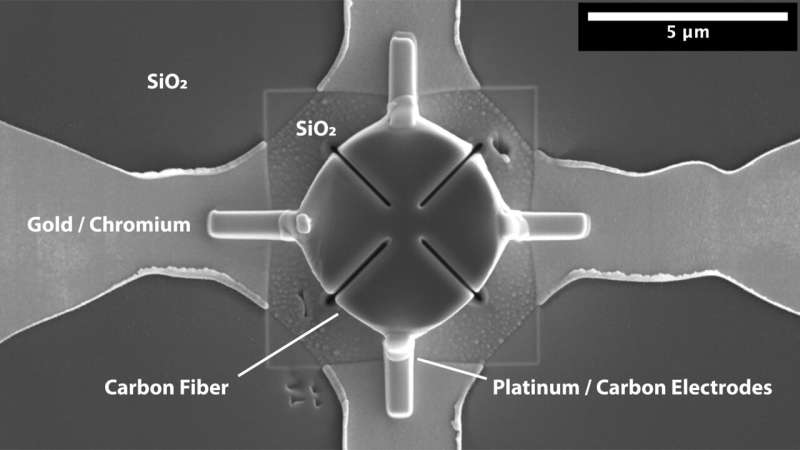Carbon fibers electrical measurements pave way for lightning strike protection technologies

Carbon fiber reinforced polymer composite structures are serving an increasingly important role in aerospace, infrastructure, energy generation, and transportation. Yet, the electrical behavior of a composite is challenging to measure or predict because of the electrical conductivity of constituent carbon fibers and the composite's complex hierarchical microstructure.
In Journal of Applied Physics, researchers from the University of Illinois at Urbana-Champaign report the first direct measurement of the transverse electrical resistivity of a single carbon fiber. The researchers combined a precise sample preparation with a technique called the van der Pauw method to accomplish this challenging measurement.
"Our experiments confirm that the electrical properties measured transverse to a carbon fiber are not the same as the properties measured along the length the of the fiber," said co-author Nancy Sottos.
When carbon fibers are made, the strong carbon-carbon covalent bonds are aligned in planes parallel to the fiber axis in the longitudinal direction. Only weak van der Waals bonds exist between the planes in the transverse direction, leading to directionally dependent properties.
The researchers used a technique known as the van der Pauw method to accurately measure the resistivity in the transverse direction of a carbon fiber. The resistance measurements were performed on a slice of carbon fiber cut using a focused ion beam and connected to electrodes for electrical resistance measurements.
"Our results reveal that an IM7 carbon fiber is more electrically conductive in the direction parallel to the length," said co-author Satoshi Matsuo.
Previously, the van der Pauw method was mainly used to measure resistivity of thin films or discs. The researchers cut and manipulated a slice of carbon fiber using a focused ion beam and a needle, a tool more commonly used to prepare transmission electron microscopy specimens.
The researchers are now working on electrical contact resistance measurements between two carbon fibers. The electrical contact resistance depends on the electrical resistivity and the contact area, which also varies depending on the angle at which the two fibers cross each other.
Next, they plan to examine the transverse electrical resistivity measurements on different types of carbon fibers with varying measurement conditions such as the environmental temperature.
"This procedure may also be applied to other homogenous conductive fibrous materials with a diameter on the order of microns such as conductive polymer fiber or metallic fiber," said Sottos.
More information: "Single carbon fiber transverse electrical resistivity measurement via the van der Pauw method" Journal of Applied Physics, aip.scitation.org/doi/full/10.1063/5.0060126
Journal information: Journal of Applied Physics
Provided by American Institute of Physics




















